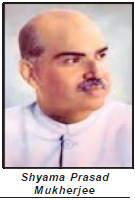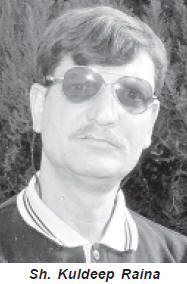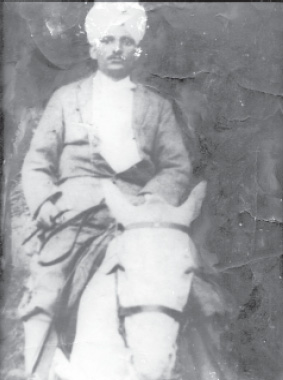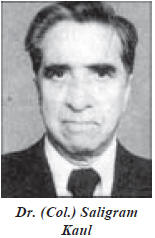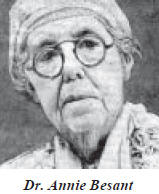Dr. Prem Nath Kachroo, the legendary Professor and a foremost researcher was a renowned Botanist of National and international fame.
His name evokes respect and reverence, he was a teacher with a difference. Besides being a hard task-master guide, a considerate friend and a perfect
![pn kachroo]() human being; he was a stunning combination of all the positive and good qualities of life all rolled in one.
human being; he was a stunning combination of all the positive and good qualities of life all rolled in one.
As an illustrious scientist, Dr. Kachroo had luminosity of contributions in the field of Biosystematics, Cytogentics, Ecology, Morphology and research studies related to the geographical distribution of plants belonging to the northwest and eastern Himalayan regions.
Being a staunch ‘devotee’ of science, he in fact ‘breathed and lived’ science. Undeniably, Prof. PN Kachroo represented the zenith of excellence in the world of science.
Shockingly, it was with stunning disbelief that the news of his unexpected and sad demise on 14th of August 2007 at New Delhi was received by his innumerable scientist colleagues, students and friends. Dr. Kachroo was a familiar name on account of his landmark research contributions.
They are of immense value in the understanding of biodiversity richness, assessment of evolutionary development relationships and adoption of conservative management measures. He had also earned name and fame for his trailblazing attainments regarding the understanding of morphological and evolutionary tendencies in the Indian Bryophytes (mosses and Liverworts). Bryophytes are a class of lower non-vascular plants, the collection and analytical classification of which is a painstaking and strenuous exercise.
This kind of energetic and efforts requiring research demands an appreciable amount of insightful knowledge, endurance and expertise, which amazingly Dr. Kachroo possessed in great amounts.
Having a modest and humble origin, Kachroo was born on 16th of October, 1924 in a middle class Kashmiri Pandit family at Alikadal, the down town area of Srinagar city. His father late Sh. Anand Ram Kachroo endowed with a religious and spiritual disposition had a knowledgeable grip on English besides the classical languages of Urdu, Sanskrit and Persian. His inspirational guidance had a telling effect in shaping young Kachroo’s earlylife.
The premature death of his father Sh. Anand Ram in the year 1942, when Kachroo was only a teenager of eighteen years deprived him of the much needed direction and protection. Hamstrung with this irreparable loss, it was left to the shattering care of his mother Smt. Daya Devi Kachroo to bring-up, educate and successfully guide her young children through all the storms and tempests of life. After completing his early education upto Intermediate examination at Srinagar, young Kachroo went all the way to Lahore to study further.
He enrolled himself in the DAV College, Lahore, where he studied Botany and Zoology apart from other subjects. Due to his passion for learning and love for the Botany subject, Kachroo went with whole hog efforts and hard labour. His hard work bore fruits and he qualified B.Sc. Hons with flying colours in the year 1946, securing first position from the then Punjab University, Lahore. In the same year, Kachroo tied the nuptial knot with Ms. Prem Lata Khoda of Mallapora, Habbakadal Srinagar. Smt. Prem Lata proved to be a constant companion to him in all the roughs and toughs of life. The unflinching interest for Botany made Kachroo to go in for specialised studies. He joined Formen Christian College, for M.Sc. Hons in the year 1947, where he chose cytomorphology as his specialised field. His extensive and high quality research at the M.Sc. level under the able guidance of Prof Prem Nath Mehra was recognised as a pioneering work. He worked in the chromosome morphology in Lilium and Fritillaria species of the Himalayan ranges. It earned him first position in the M.Sc. examination in 1948.
Later on, he joined as senior Research scholar under the guidance of Prof. P.N. Mehra, who by then had come to occupy the coveted position of the Head of the University Department of Botany, which was then housed in Khalsa College Amritsar. The topic of his Ph.D research was chromosome morphology and sporting germination in the Indian Hepaticae, with special reference to Rebouliaccea.
He was awarded the Ph.D degree in the year 1955. His work was widely appreciated and acclaimed as a remarkable research contribution. It later on formed the basis of Prof. Mehra’s address at the International Botanical Congress held at Moscow (Russia). Soon after, Dr. Kachroo left Amritsar in 1950 to join the honoured and exalted profession of a teacher in the post-graduate department of Botany at the Univerxsity of Gauhati, Assam.
At Gauhati, the nearness of the surrounding foliage, particulary that of Bryophytic and Pteridophitic flora made Dr Kachroo to undertake the massive resarch in this specific field.
His splendid research accomplishments mostly individually and a few jointly with Prof. B.K.
Nayar inthe field of of Taxonomy, floristics, morphology and phytogeography of the ferns of Assam occupies a place of pride in the research world.
They were hailed as exceptional works in terms of valuable original insights. Notwitstanding it, his interest and fascination for Bryology did not wana. His subsequent immaculately researched studies in Bryology particularly his works on Hepaticae are even now regarded as most comprehensive.
His almost insatiable hunger for scientific research made Dr. Kachroo to leave his job at Gauhati University in 1955.
He then joined Damodar Valley Corporation (DVC) as a Botanist with headquarters at Burdwan, West Bengal. Here his research work was mainly centered on the ecology of the mainland water bodies of DVC specific areas. He concentrated his work on the study of aquatic vegetation in relation to the breeding of Anopheles mosquito larve in the area extending from Kolkatta to Hazaribagh. It also involved in the adoption of measures for checking the growth of water weeds at the DVC site.
In 1956, Dr. Kachroo left for America to avail the Smith Mundit Fullbright Fellowship to study the phytogeography of Alaska at the University of Michigan. However, due to certain developments, his work shifted to Taxonomic aspect of the family Lejuneacea (Hepaticea), which he undertook jointly with the fellow researcher Rindolf. M. Schuster, His tiresome research study paid-off handsomely as Dr. Kachroo succeeded in detecting several new genera and groups. He returned back to India in 1959 to join as Editor of the Research publications in the prestigious Indian Council of Agriculture Researcher, New Delhi. During his stay here, he authored valuable books on scientific editing and ferm gardening besides publishing census of Indian Hepatica.
However, the lure of his homeland Kashmir proved irresistible and he returned to his native land. He joined as Professor and head, department of Botany, J&K University, Srinagar in 1967.
During his impacting service of 23 years at the Kashmir University, the department of Botany hummed with academic and research-oriented activities.
His uplifting watchful gaze and inspiration presence gave a new resbnance to the Botany department. The successful completion of record number of thirty four Ph.D and more than fifteen M.Phils is a knowing confirmation of his able guidance and scientific genius. The department of Botany achieved phenomenal increase in the Botanical research in the J&K State with emphasis centered on floristics., cytogenetics, ecology, morphology and phytogeography of the flora of the state. Dr. Kachroo also undertook practical and objective measures to ensure advancement and growth of the studies connected with plant physiology, plant morphology and plant taxonomy. It proved a milestone in the furtherance of the research connected with the dispersal, distribution and diversity of the flora extending right from the alpine region to Kashmir Valley and plains of Jammu division. His subsequent interest developed for ethonobotanical properties of the wild flora later on stimulated the studies related to various sociocultural aspects of Kashmiris.
His vast knowledge, extensive experience and meaningful guidance combined with the assistance of his highly devoted and sincere research workers made the phytogegraphic documentation of several regional floras possible. These studies gave on organised shape to the concept of approximating affinities between Kashmir and Central Asian floras. Apart from it, it also provided insightful knowledge not only about the origin of Kashmir flora but also about the connecting distributional lines of various taxa. The revealing research work undertaken under the guidance of Dr. Kachroo on the disturbing ecological trends of the Dal Lake, Srinagar marked another spectacular contribution of the department of Botany, Kashmir University. Though originally a cytologist and evolutionary Botany, Prof. Kachroo utilised a multidimensional strategy for comprehending the principles of the biodiversity of the J&K State. His research studies on the cytological peculiarities in ferms, Irises Potentillas and alpine flora are regarded as Prof. Kachroo’s distinguished contribution, Also, the Botanical garden of Kashmir University with its’ serenity, quietness and pastoral ambience, nurtured during his headship is a speaking example of his practical guidance.
Despite his retirement from active service on 31/10/1984, Prof. Kachroo continued to work in the Botany department in his capacity as Director of Centre for Plant Taxonomy, which he established and nurtured.
Besides being Head, department of Botany and Pharmacy, Kashmir University, he also served as Dean, Faculty of Science, Associate Director (Kashmiri language), National Science Talent Search scheme and Project officer, Survey of medicinal plants unit. In addition, Prof, Kachroo was also Emeritus Fellow, UGC and Emeritus Scientist, Department of Environment and Forests Govt. of India. He also served as officiating Vice-chancellor of Kashmir University during the years 1978- 79, 1981-82 and 1983-84. He also functioned as founder Project officer, Survey of medicinal plants, Unani medicines, Member syndicate Jammu University, Member Advisory Board of RRL, Jammu and Member of the Selection Committees of Indian Agriculture Scientist Recruitment Board.
The immensely rich compendium of about a dozen Books, more than two hundred research publications, eighteen monographs and eleven major research projects are regarded as remarkable legacies left behind by Dr. P. Kachroo.
The outpouring of the welledup emotions and feelings on the sad demise of Prof. Kachroo on August 11, 2007 at New Delhi was intense and spontaneous, cutting across caste, creed and regional lines. In a condolence meeting held by the Department of Botany and Heads of Science Departments of Kashmir University on 14/8/2007, rich tributes were paid to the departed soul.
The Vice-Chancellor of Kashmir University Prof. Abdul Wahid and other faculty members remembered Dr. Kachroo as “an ideal teacher, wonderful researcher and a perfect human being”.
Recalling his 23 years of dedicated service to Kashmir University, they paid sincere homage in the following words.
“His zeal and zest for knowledge made him to occupy yhr highest academic pedestal in Kashmir University. His multi-disciplinary approach made him an all round Botanist of national and international fame.” “His contribution to the development of Botany Department and corporate life of Kashmir University are the beacon lights for us to follow,” remarked Prof.
AK Munshi Head of the Deptt. of Botany, Kashmir University.
On a similar sorrowful note, Prof. Azar Azar A. acknowledged Prof. Kachroo, as “an accomplished Botanist, who kept burning the lamp of scholarship kindled by him”.
Dr. Shashikant, former Head of Botany Deptt. Jammu University, who was also one of the first research scholars of Dr.
Kachroo in 1967 at Srinagar paid sincere homage in the following words. “Apart from being a foremost Botanist of India, Dr.
Kachroo was a writer par excellence besides being a noble human being, who knew no boundaries.” Speaking in the same vein, Dr. Shashikant continued”, Dr. Kachroo’s association with the stalwarts in Botany both at the national and international levels was well recognised”.
Dr. R.N. Gohil, former Head of the Botany Department, Jammu University and a former colleague at Srinagar spoke with reverence, “Dr. Kachroo was a practical person, a doer, who always remained on the toes for research”.
“He was a renowned scientist, was everwilling to explore the inaccessible and isolated areas for the study of area specific flora,” fondly remembered Dr. Gohil.
Dr. V.K. Anand, Dean Life Sciences Jammu University remarked, “my association with Dr.
Kachroo dates back to 1971, when I joined Kashmir University as a M.Sc. student. A man of few words, he had all the affirming qualities of head and heart”.
“Prof. Kachroo led a life full of activity and research. Neither the advancing age nor time would stale his passion for research”, voiced Dr. A.K. Wakhloo, Head Department of Botany Jammu University.
Dr. Bimal Misri Principal Scientist and Head, Regional Research Centre, Indian Grassland and Folder Research Institute.
CSK Himachal Pradesh KV Campus), Palampur, paid his heartfelt tribute in the capacity of a former student, “A glorious era of Kashmir Botany has come to an end with the demise of Dr.
Kachroo. Besides being a teacher, he was a keen researcher, excellent editor, simple man, strict vegetarian and a man of fine things of life. “Continuing his sincere tributes, Dr. Misri summed-up, “Dr. Kachroo never restricted himself to a particular subject of Botany. His innumerable reserach papers on Bryphytes, Pteridophytes, Grasses, Forest and Aqautic ecosystems, Cytogenetics, Plant Anatomy and Taxonomy firmly establish. Dr. Kachroo as a genius and master of Botany, who was wedded to research.” A visibly shocked Dr. B.L Saproo, a student of yore and subsequently Dr. Kachroo’s Colleague at Srinagar also expressed his glowing tributes in the following words, “Prof. Kachroo was a Botanist par excellence, he believed in simple living and high thinking, love for all, hate for none, a true conservationist, who used even blank portions of letters for jotting research notes”.
Speaking about the full flowering of Prof. Kachroo’s genius, Dr Ashwani Wangnoo, Professor Deptt. of Limnology, Barkat Ullah University Bhopal also expressed his sincere tributes, “Prof. Kachroo was a Professor of national fame, even his advanced age and failing health did not lessen his urge for scientific did not a lessen his urge for scientific pursuits. Inspite of his failing health, he came to Bhopal at my behest far Ph.D viva only last year i.e. 2007.” Dr. Kachroo was a co-guide of Dr. Shiban K.Dhar, Senior Scientist and Dy. Director Central Silk Board Jammu. “Dr.
Kachroo was a perfect Scientific Icon, an all-round achiever, who lived to strive, search and find,” remarked fondly Dr. S.K. Dhar.
Dr. Virjee Koul, Lecturer at GGM Science College Jammu summed up his tributes in the following words, “Despite being a scientist of international fame, Prof. Kachroo led a simple life and was accessible to everyone.
Till his last breath, he contributed relentlessly in the field of Botany, a subject he loved.” A student of yesteryears and presently a lecturer at GGM Science College (evening) Jammu, Dr. Ranjana Koul recalled, “Prof. Kachroo was a metaphor for all that is good. Inspite of being a reputed scientist, he remained a student and a scholar, who was always absorbed and immersed in research”. Dr. R.K. Ogra, senior scientist, Himalayan Bioresources Institute, Palampur, Dr. Ravinder Raina, Senior Scientist, Dr Y.S. Parmar University of Horticulture and Forestry, Nauni Solan. Dr. Kirti Koul, Head of Botany Deptt.
Jivaji University Gwalior and Dr. Upender Dhar, Director, GB Pant Institute of Himalayan Ecology and Dev., Almora the former students of Prof. Kachroo were also shocked at his sad demise.
My respectful memories of Professor Kachroo date back to my student days, when he used to teach us Economic Botany.
These fond recollections which stir emotional and sincere memories are now a part of my memory treasure.
Dr. Kachroo’s lone son Sh. Perry Kachroo married to Mrs. Renuka and having two sons is settled in USA. The eldest daughter of Prof. Kachroo, Mrs. Priyadashani is married to Dr. MJ Zarabi, who is a Managing Director of Software Computers, India, Mohali Chandigarh. She is blessed with two daughters, Manat Zarabi Dr. Mansha Zarabi. Another son of Prof. Kachroo namely Pimmy Kachroo had at sudden and premature death decades pack when he was a student of Agriculture Engineering at Ludhiana. His demise shocked Prof. Kachroo, who carried the burden of the painful trauma throughout his life. Unquestionably, Dr. P.N. Kachroo, the renowned Botanist was truly an icon of not only of the J&K. State but also the entire nation. He was a multi-layered personality, who as a scientist lived his life to the full and for whom life was entirely a scientific sojourn.
PHOTO ESSAY
![pn kachroo pn kachroo]()
![pnk1 pnk1]()
![pnk2 pnk2]()
![pnk3 pnk3]()
![pnk4 pnk4]()
![pnk5 pnk5]()
![pnk6 pnk6]()
![pnk7 pnk7]()
![pn kachroo pn kachroo]()
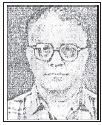 He was ‘Shyama’ (Divine Mother’s) ‘Prasad’ born). So he remembered three times the Mother, before he left this mortal frame. First he remembered the mother who gave him birth and next he remembered the Mother India (Bharat Mata) for whose sake he sacrificed his life and lastly he remembered the Divine Mother Shyama, who embraced him and took him to his heavenly abode.
He was ‘Shyama’ (Divine Mother’s) ‘Prasad’ born). So he remembered three times the Mother, before he left this mortal frame. First he remembered the mother who gave him birth and next he remembered the Mother India (Bharat Mata) for whose sake he sacrificed his life and lastly he remembered the Divine Mother Shyama, who embraced him and took him to his heavenly abode.